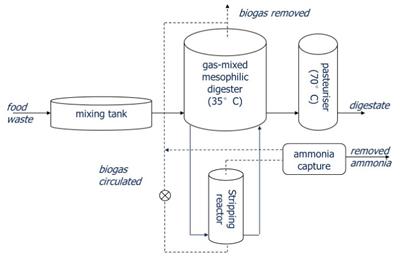Research project: Optimising processes for the stable operation of food waste digestion
Funded by Defra
Funded by Defra
Anaerobic digestion (AD) is normally considered to be a stable process for the treatment of organic wastes and the production of biomethane. It is based on specialised bacteria that break down the organic materials by means of enzymes which in some cases are highly specific and contain trace quantities of rare metals. There are situations where the process stability is upset as a result of conditions within the digester, however, which in turn may be strongly influenced by the feedstock characteristics. One of the most common occurrences in this respect is due to a low carbon: nitrogen (C:N) ratio which for a digester fed at a normal loading leads to excess nitrogen in the form of ammonia. Ammonia has been recognised for at least 45 years as being toxic to the AD process, although it is now recognised that under some conditions the anaerobic bacteria can adjust themselves to tolerate higher concentrations.
There are numerous examples where the AD process has suffered as a result of high ammonia concentrations, for example in digestion of cattle manure, pig slurry, chicken litter, abattoir wastes and food wastes. In the case of food wastes, the effects of high ammonia were clearly seen in technical-scale trials using kitchen waste collected in the UK, and were almost certainly the cause of digester instability in a 30,000 tonne per year food waste digester operated by Valorsul SA in Lisbon, Portugal. The same conditions have also been observed in numerous laboratory-scale research studies on AD, as the phenomenon is caused not by the size of digester but by the microbiological and biochemical processes occurring within the system. The problems are fundamentally related to the nature of the input material and in the case of food waste are because of its high protein content which leads to an unbalanced C:N ratio. The current research is directed towards source segregated food waste collected from domestic kitchens. Compositional analysis has shown this to have a C:N ratio in the critical range, and problems are known to have occurred in digesters operating on this feedstock in a number of locations and at all scales. To confirm the common characteristics of source segregated domestic food waste in the UK, samples from two sources in addition to the material used in the study were analysed. The problems resulting from high ammonia are due to the inhibition in conventionally-operated mesophilic systems of an important group of microorganisms known as the acetoclastic methanogens. The current research investigated the options for removal of ammonia as part of the digestion process to reduce it to a concentration that allows stable and efficient operation. A number of approaches were used, including considering the potential for removal of ammonia in a gaseous state from the digester itself or from a pre-processing tank.
There is also a second problem associated with the digestion of certain waste substrate types, due to deficiencies in trace elements. The absence of these can result in digester failure as the microbial community fails to break down the intermediate products formed into methane and carbon dioxide. This results in an irreversible accumulation of acid products causing direct toxicity and pH change. A good example of a system believed to have failed for this reason is a full-scale digestion plant in Canada which was fed on source segregated food waste: the process was eventually stabilised by addition of a cocktail of trace elements. In the case of a deficiency in trace elements, digester failure may not appear for many months as, as the seed sludge used to start up the digester is often taken from municipal wastewater treatment plants or animal slurries, which contain sufficient trace metals for start-up and the early stages of operation. The current research identified potential trace metal deficiencies in digestion of domestic food wastes and proposed suitable supplements


Theme Water and Environment